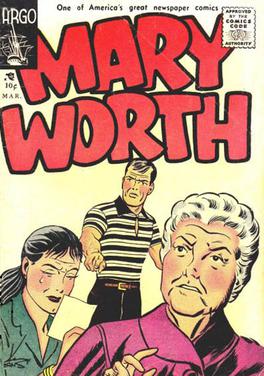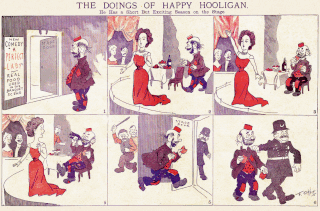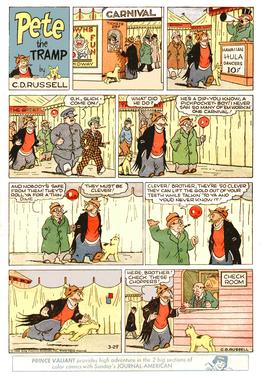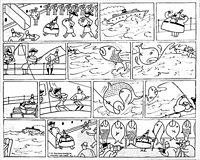
A comic strip is a sequence of cartoons, arranged in interrelated panels to display brief humor or form a narrative, often serialized, with text in balloons and captions. Traditionally, throughout the 20th and into the 21st century, these have been published in newspapers and magazines, with daily horizontal strips printed in black-and-white in newspapers, while Sunday papers offered longer sequences in special color comics sections. With the advent of the internet, online comic strips began to appear as webcomics.

The Katzenjammer Kids is an American comic strip created by Rudolph Dirks in 1897 and later drawn by Harold Knerr for 35 years. It debuted December 12, 1897, in the American Humorist, the Sunday supplement of William Randolph Hearst's New York Journal. The comic strip was turned into a stage play in 1903. It inspired several animated cartoons and was one of 20 strips included in the Comic Strip Classics series of U.S. commemorative postage stamps.

The National Cartoonists Society (NCS) is an organization of professional cartoonists in the United States. It presents the National Cartoonists Society Awards. The Society was born in 1946 when groups of cartoonists got together to entertain the troops. They enjoyed each other's company and decided to meet on a regular basis.

Mary Worth is an American newspaper comic strip that has had an eight-decade run from 1938. Distributed by King Features Syndicate, this soap opera-style strip influenced several that followed. It was created by writer Allen Saunders and artist Dale Connor, initially appeared under the pseudonym "Dale Allen". Ken Ernst succeeded Connor as artist in 1942.

King Features Syndicate, Inc. is an American content distribution and animation studio, consumer product licensing and print syndication company owned by Hearst Communications that distributes about 150 comic strips, newspaper columns, editorial cartoons, puzzles, and games to nearly 5,000 newspapers worldwide. King Features Syndicate also produces intellectual properties, develops new content and franchises, like The Cuphead Show!, which it produced with Netflix, and licenses its classic characters and properties. King Features Syndicate is a unit of Hearst Holdings, Inc., which combines the Hearst Corporation's cable-network partnerships, television programming and distribution activities, and syndication companies. King Features' affiliate syndicates are North America Syndicate and Cowles Syndicate.

James Edward Murphy Jr. was a self-taught American cartoonist who is best known for his long-run family comic strip, Toots and Casper. His earliest strips, signed J.E. Murphy, had a crude awkward look, but as his cartooning improved, his full signature of Jimmy Murphy appeared.

Henry is a comic strip created in 1932 by Carl Thomas Anderson. The title character is a young bald boy who is mute. Except a few early episodes, the comic strip character communicates largely but not entirely through pantomime, a situation which changed when Henry moved into comic books. Henry has spoken in at least one Betty Boop cartoon from 1935. In the feature, Betty Boop has a pet shop and Henry speaks to a dog in the window.

The New York Journal-American was a daily newspaper published in New York City from 1937 to 1966. The Journal-American was the product of a merger between two New York newspapers owned by William Randolph Hearst: The New York American, a morning paper, and the New York Evening Journal, an afternoon paper. Both were published by Hearst from 1895 to 1937. The American and Evening Journal merged in 1937.

The Sunday comics or Sunday strip is the comic strip section carried in most western newspapers. Compared to weekday comics, Sunday comics tend to be full pages and are in color. Many newspaper readers called this section the Sunday funnies, the funny papers or simply the funnies.

Otto Soglow was an American cartoonist best known for his comic strip The Little King.

Carl Thomas Anderson was an American cartoonist best remembered for his comic strip Henry. Readers followed the pantomime adventures of the mute, bald-headed Henry in strips which he signed with his familiar signature displaying an enlarged "S": Carl AnderSon.

The Little King is an American gag-a-day comic strip created by Otto Soglow, which ran from 1930 to 1975. Its stories are told in a style using images and very few words, as in pantomime.

Radio Patrol is a police comic strip carried in newspapers from August 7, 1933 to December 16, 1950 in the dailies, with a Sunday strip that ran from November 25, 1934 to October 20, 1946. It was created by artist Charles Schmidt and writer Eddie Sullivan, who both worked for the Boston American. Sullivan was a newspaper reporter who specialized in crime reporting.

Little Jimmy, originally titled Jimmy, is a newspaper comic strip created by Jimmy Swinnerton. With a publication history from February 14, 1904, to April 27, 1958, it was one of the first continuing features and one of the longest running.

Happy Hooligan is an American comic strip, the first major strip by the already celebrated cartoonist Frederick Burr Opper. It debuted with a Sunday strip on March 11, 1900 in the William Randolph Hearst newspapers, and was one of the first popular comics with King Features Syndicate. The strip ran for three decades, ending on August 14, 1932.

Barney Baxter in the Air is an American comic strip by Frank Miller. It started its run on September 30, 1935, for the Denver's Rocky Mountain News. Starting on December 7, 1936, it was syndicated by King Features. Barney Baxter was an "adventure strip" involving heroic exploits centering on aviation.
A comic strip syndicate functions as an agent for cartoonists and comic strip creators, placing the cartoons and strips in as many newspapers as possible on behalf of the artist. A syndicate can annually receive thousands of submissions, from which only two or three might be selected for representation. In some cases, the work will be owned by the syndicate as opposed to the creator. The Guinness World Record for the world's most syndicated strip belongs to Jim Davis' Garfield, which at that point (2002) appeared in 2,570 newspapers, with 263 million readers worldwide.

Pete the Tramp is an American comic strip by Clarence D. Russell (1895–1963) which was distributed by King Features Syndicate for more than three decades, from January 10, 1932 to December 22, 1963. Howard Eugene Wilson, in the Harvard Educational Review, described the strip's title character as "a hobo with a gentleman's instincts."

Clarence D. Russell was an American cartoonist best known for his syndicated comic strip Pete the Tramp.
Donald Duck is an American comic strip by the Walt Disney Company starring Donald Duck, distributed by King Features Syndicate. The first daily Donald Duck strip debuted in American newspapers on February 7, 1938. On December 10, 1939, the strip expanded to a Sunday page as well. Writer Bob Karp and artist Al Taliaferro worked together on the strip for more than 30 years. The strip ended in May 1995.

















